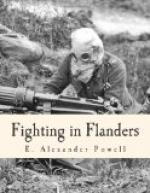Thompson remained in the fort to take pictures. When darkness fell he made his way back to the village of Waelhem, where he found a regiment of Belgian infantry. In one of the soldiers Thompson recognized a man who, before the war, had been a waiter in the St. Regis Hotel in New York and who had been detailed to act as his guide and interpreter during the fighting before Termonde. This man took Thompson into a wine-shop where a detachment of soldiers was quartered, gave him food, and spread straw upon the floor for him to sleep on. Shortly after midnight a forty-two centimetre shell struck the building. Of the soldiers who were sleeping in the same room as Thompson nine were killed and fifteen more who were sleeping upstairs, the ex-waiter among them. Thompson told me that when the ceiling gave way and the mangled corpses came tumbling down upon him, he ran up the street with his hands above his head, screaming like a madman. He met an officer whom he knew and they ran down the street together, hoping to get out of the doomed town. Just then a projectile from one of the German siege-guns tore down the long, straight street, a few yards above their heads. The blast of air which it created was so terrific that it threw them down. Thompson said that it was like standing close to the edge of the platform at a wayside station when the Empire State Express goes by. When his nerve came back to him he pulled a couple of cigars out of his pocket and offered one to the officer. Their hands trembled so, he said afterwards, that they used up half a box of matches before they could get their cigars lighted.
I am inclined to think that the most bizarre incident I saw during the bombardment of the outer forts was the flight of the women inmates of a madhouse at Duffel. There were three hundred women in the institution, many of them violently insane, and the nuns in charge, assisted by soldiers, had to take them across a mile of open country, under a rain of shells, to a waiting train. I shall not soon forget the picture of that straggling procession winding its slow way across the stubble-covered fields. Every few seconds a shell would burst above it or in front of it or behind it with a deafening explosion. Yet, despite the frantic efforts of the nuns and soldiers, the women would not be hurried. When a shell burst some of them would scream and cower or start to run, but more of them would stop in their tracks and gibber and laugh and clap their hands like excited children. Then the soldiers would curse under their breath and push them roughly forward and the nuns would plead with them in their soft, low voices, to hurry, hurry, hurry. We, who were watching the scene, thought that few of them would reach the train alive, yet not one was killed or wounded. The Arabs are right: the mad are under God’s protection.




